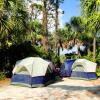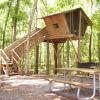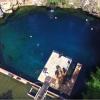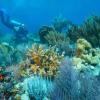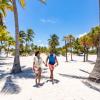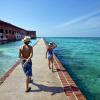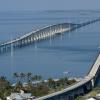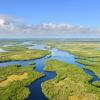By Lauren Tjaden
A National Park and a national treasure, Dry Tortugas promises a remote tropical paradise, a symphony of private beaches, crystalline waters and turquoise fish. Dominated by Fort Jefferson, the largest brick building in the western hemisphere, the park invites you ditch your sandals, snorkel its vivid coral reefs, and discover its turbulent past.
Location, Location, Location
Accessible only by boat or seaplane, the 100-square mile Dry Tortugas National Park is sited 70 miles (113 km) west of Key West. Predominately open water, dotted with seven small islands, it’s the very definition of secluded. Take a peek at Dry Tortugas National Park’s Fort Jefferson on Google Maps, then click on the satellite feature and you’ll start to understand.
Garden Key, encompassing a whopping 14-acres, is the second largest island in the Dry Tortugas. It’s home to park headquarters, a visitor center, campgrounds, and offers incredible swimming and snorkeling. Its central feature is historic Fort Jefferson, one of the nation’s largest 19th century forts.
Garden Key is the only location in the Dry Tortugas that visitors can access without their own boats, and that’s the area that’s the focal point of this article.
Experiences, Adventures and Must-Dos
Swimming and Snorkeling
Dry ground is in short supply in Dry Tortugas National Park – in fact, over 99% of the park is water-- and that means the best way to appreciate it is by getting wet.
And the underwater world is spectacular. The Park is sited at the southwest corner of the Florida Keys reef system, the third largest in the world. Due to its remote location and the easterly flowing gulf current just south of the park, it promises both a greater abundance of marine life and frequently much larger versions of it than anywhere else in the Florida Keys. On a snorkeling expedition, expect to see a myriad of colorful tropical fish and vibrant, living coral beneath a mere four to seven feet of gin-clear water, directly off a brilliant white sand beach.
The swim areas on Garden Key are accessible via North, South, and East Beach, with beaches that offer a gradual slope and easy entry, perfect for beginner swimmers and snorkelers.
Swimming Safety Tips
- There are no lifeguards, so you swim at your own risk.
- Make sure to stay within your abilities.
- Watch kids closely.
- Don’t swim alone.
- Beware of strong current.
- Don’t touch or stand on coral or stand on seagrass.
- Don’t enter the moat or dive from the walls.
Snorkeling Safety Tips
- Make sure that your equipment fits properly
- Use a snorkel floatation vest
- There are no lifeguards, so you swim at your own risk
- Stay inside the designated snorkel area. Here’s where you can download a map of the Fort Jefferson snorkel areas.
- Never snorkel alone - always use the “buddy system.”
- Beware of fast-changing tropical weather
- Beware of sunburn; wear a rash guard or reef safe sunscreen
Explore Fort Jefferson
The centerpiece of Garden Island is Fort Jefferson, a massive, imposing presence on the tiny key. To investigate it is to take a stroll through the past—one that’s boiling with strife, sorrow and bold personalities.
Intended for a federal installment for ships to patrol the Gulf of Mexico, construction on Fort Jefferson began in 1846.
By any measure, the octagonal-shaped fort is gargantuan. Just its numbers are mind-blowing.
Four sides are 477 feet long; two are 325 feet. Its 45-foot-high walls overlook a 70-foot-wide moat, and its lighthouse stretches 155 feet into the air. A staggering sixteen million bricks were used in its construction, a project never quite completed.
Two hundred arches support the interior. Cisterns collected 1,500,000 gallons of rainwater. More than 400 heavy guns took aim at the sea. Thousands of overlooked workers, including slaves, provided the hard labor.
Garden Key Visitor Center is located inside Fort Jefferson. The visitors center delivers artifacts, an informational movie, a bookstore, and souvenirs.
It’s for the Birds
For birdwatchers, the Tortugas are heaven on Earth. In 1832, John James Audubon, the renowned naturalist and artist, wrote about the islands. “On landing I felt for a moment as if the birds would raise me from the ground so thick were they all around, and so quick the motion of their wings. Their cries were deafening.’’
In the 21st century sometimes you may still need to shout to be heard. The Tortugas are the only place in the continental United States where endangered sooty terns nest, and they’re home to the only known nesting colony of frigate birds. In the summer, these magnificent creatures patrol the skies over Fort Jefferson, peering at the tourists below.
In the spring, when migrating birds from Cuba, Central America and South America are heading north, they often stop for a much-needed rest on the islands of the Tortugas. Some visitors have witnessed what’s nicknamed ‘the fallout,’ days when exhausted birds seem to be tumbling out of the air every second. A single gumbo limbo tree might provide a resting spot to hundreds of panting hummingbirds, while Peregrine falcons stake out positions on the fort walls while they gather their strength.
More than 299 different species of birds have been officially spotted at Dry Tortugas, and it’s common to see 70 or more species in a single day in springtime. Bird activity is greatest from March through September. Migratory birds peak in April and May.
Fishing
Dry Tortugas National Park provides an excellent fishing destination. You’ll need a Florida Saltwater fishing license to fish there, unless you’re under the age of 16 or a Florida resident senior over the age of 65.
Private boaters are required to file a boat permit at Garden Key before fishing within the park. Spearfishing and lobstering is prohibited. If you enter park waters, all spearfishing gear should be disassembled and stored away.
“J" hooks aren’t permitted; only "circle" hooks are allowed. Please note, there aren’t gear or supply shops inside the park.
Fishing in the Research Natural Area is prohibited.
Fishing Locations Include
- The seaplane beach east of the main dock, when the seaplane isn’t present.
- The main dock, when the Yankee Freedom isn’t present.
- Two westernmost finger piers, when they’re unoccupied.
- Either dinghy beach, provided that fishing doesn’t occur within 50 feet of the concrete wall of the historic docs and the ruins previously used for loading coal.
- All other areas of Garden Key are closed to fishing. Fishing from a boat is permitted within the one-mile Historic Use Area of Garden Key.
Florida Travel: Remote Island Camping in the Keys at Dry Tortugas
Let the Surf Sing you to Sleep
You can camp near Fort Jefferson on Garden Key, and the star gazing, snorkeling, and sunsets promise to make this adventure one that will remain vivid throughout your life. But don’t forget the can opener-- the nearest convenience store is a long way off.
The primitive campground is a short hike from the public dock, offering eight regular sites that can accommodate up to six people. Reservations aren’t accepted, but all campers, once they arrive, are guaranteed a place to camp.
Here's more information from Dry Tortugas National Park about camping rules, how you should plan, and everything you need to bring—including water. Remember the word ‘dry’ in the park’s name.
What’s in a Name (and in the Water)
Ponce de Leon, the Spaniard who named the North American continent ‘La Florida’ in 1513, also named the Dry Tortugas when the conquistadors stopped there to gather birds, eggs and turtles for food. Due to the abundant sea turtle population, Ponce dubbed the key “La Isla de Tortugas’’ -- the island of turtles. Later, mariners added one more word— ‘dry,’ as the only drinking water came from rain puddles.
The name was, and is, apt.
Five species of sea turtles are found in the Dry Tortugas region, which are Green, Loggerhead, Kemp's Ridley, Hawksbill, and Leatherback. Unfortunately, years of hunting have taken their toll, and these once plentiful turtles have now all landed on the Endangered Species List.
In modern times, the Park, the most active turtle nesting site in Florida, provides a beacon of hope. Park biologists monitor sea turtle nesting activity, surveying the seven islands within the park boundaries each day throughout the nesting season and documenting the presence of turtle tracks or ‘crawl.’ Their news is outstanding: Over 2,330 Loggerhead and Green turtle crawls have occurred during the last four seasons on a mere three miles of beach.
History
Fort Jefferson was home to hundreds of soldiers and prisoners during the Civil War, who endured the monotony of living on a 14-acre island paired with chronic malnutrition—and most, if not all of them, would argue with the Dry Tortugas’ modern reputation as a tropical paradise.
When the supply ship would arrive from Key West, bringing Key limes, it was reason for celebration as citrus prevented scurvy.
While from October through March the climate was tolerable, the other six months of the year were a trial. One prisoner wrote, “The heat was intense, the silence oppressive beyond description.’’
The Fort’s most notable prisoner was Dr. Samuel Mudd, who cared for John Wilkes Booth after he murdered President Abraham Lincoln and fractured a leg while escaping. While innocent, in 1865 the epically unfortunate Mudd was convicted of conspiracy and sentenced to life at hard labor.
In 1867, a yellow fever epidemic rampaged through the fort, infecting half of its 800 residents. Though the sick were evacuated to a neighboring island (now called Hospital Key), people kept dying, including the fort’s doctor. Prisoner Mudd, who offered to doctor the sick and dying, was pardoned by President Andrew Johnson in 1869.
Fort Jefferson served the Union during the Spanish-American War and World War I, and in 1935, President Franklin D. Roosevelt designated Fort Jefferson as a National Monument.
In 1942, the park superintendent grumbled in a letter about his diet, “Anything can become monotonous in time, and did you ever try eating lobster two or three times a day or several weeks?” He tried planting a garden, to establish something green, but the land crabs devoured the vegetables.
Getting There
70 miles of open water and no road traversing it means you have three choices to get the Tortugas, on the fly, on the ferry, or BYOB—that is, bring your own boat.
Comfy Cat
For around $200, you can hop aboard the ADA compliant Yankee Freedom III, the official Dry Tortugas ferry, for a two-hour-and-15-minute air-conditioned catamaran ride to the National Park. Your ride comes complete with complimentary breakfast and lunch; spacious sundeck seating; freshwater showers; three restrooms; a snack bar and even a cocktail bar (only open on the return trip). Step out onto the deck and take in the fresh salt air, and keep your eyes peeled for passing sharks, rays or sea turtles. Words to the wise: On a windy day, if the ferry makes the trip, bring your sea legs. Here are FAQs you should know, including directions, parking, what to bring and what not to bring.
Splurge on a Seaplane
When you book a seat with Seaplane Adventures, the only seaplane service to Dry Tortugas National Park and Fort Jefferson, it’s a $370 extravagance—and it means you’ll be walking down the beach in only 45 minutes.
On these stunning, low-altitude flights, narrated by a pilot who doubles as your personal tour guide, everyone snags a window seat and a headset. While aboard, you’ll discover that the Florida Keys don’t end in Key West; that’s just where the highway ends. The island chain stretches 70 miles further, directly under your flight route.
The views and the experience are grand. You’ll see Key West from the air, and soar over an area known as the "Flats," a body of extremely shallow water that extends almost 20 miles, revealing sharks, stingrays and the occasional porpoise. Shipwrecks make the flight even more wondrous, including the "Arbutus," with its mast still peeking above the water. And the traditional low pass over Fort Jefferson makes for a blockbuster arrival. Don’t forget your camera.
Words to the Wise: Book early as during peak times, these flights can fill several months in advance. Make sure to check out things to know from Seaplane Adventures: for instance, you need to bring snacks as the company doesn’t supply them and there are none available at Dry Tortugas. Inclement weather can cause your flight to be cancelled.
BYOB
Bringing your own boat to Dry Tortugas National Park provides visitors with remarkable opportunities to explore this pristine gem, but its isolated location and the fact that no food, water, or fuel are available in the park mean proper planning is paramount. Here’s information on permits, tides, weather, anchoring and prohibited items.
What to Bring and What Not to Bring
Garden Key offers a couple of water fountains and an air-conditioned gift shop that becomes particularly desirable in the summer months. But outside of those amenities, there’s little hint of modern conveniences in the Dry Tortugas.
This means you won’t find restaurants, shops, or any other services that offer food, water or fuel on the islands of Dry Tortugas National Park. The ferry provides breakfast and lunch for its passengers. All other visitors need to plan on bringing whatever they need for personal comfort, hydration, and sustenance for their trip.
And your cellphone won’t work, which means you won’t be able to post your adventures on Facebook until after the fact.
Salute the park rangers who live in Fort Jefferson these days, often for extended periods, as this special breed is a throwback to an earlier era.
You should bring...
- Towels and a bathing suit
- Camera
- Sunscreen (preferably reef safe)
- A change of dry clothes
- Snacks or a packed lunch (depending on how you get to the island and what’s provided with the trip)
- A mask and snorkel (depending on how you get to the island and what’s provided with the trip)
- You don’t need cash on the island, but you may want to bring a small amount for the Park Service Gift Shop.
You Shouldn’t Bring...
- Dive tanks, weights or knives
- Underwater scooters
- Flammable liquids or gas stoves
- Large coolers
- Styrofoam coolers
- Dogs or other pets
- Beach chairs or shade umbrellas; but you’ll find plenty of picnic tables provided by the National Park Service.
- Drones
What to Know
When to Go
No public restrooms are available at the park, but you can use the facilities provided onboard the Yankee Freedom. Composting toilets are available for visitors to use within the campground and after 2:30 p.m.
It’s Only Natural
You can’t bring home seashells, coral and other natural objects that you find on the island—and that includes sand, brick, glass, stone, metal or any other natural or historic objects from the premises. If you find an artifact, please don’t move or disturb it, and contact park staff.
Do Not Enter
Some areas of Fort Jefferson are closed to the public. To ensure your safety, don’t go into these clearly marked areas, and follow all park regulations. The interior of Fort Jefferson is only open during daylight hours.
Just the FAQS
Check out the answers to frequently asked questions from Dry Tortugas National Park, including if there are trash receptacles (no, you need to pack everything out that you bring in); what you’re allowed to bring on the ferry, and much more.
PLACES TO REMEMBER
RELATED CONTENT
Snorkeling & Diving
Want to see another world? Try snorkeling or scuba diving in Florida, and experience brilliant reefs, historic shipwrecks and multicolored marine...
Caladesi Island State Park
Located off Florida’s Gulf Coast, west of the town of Dunedin and near the city of Clearwater, Caladesi Island State Park is famed for their...
Everglades National Park
The legendary River of Grass is one of the wonders of the world, a vast subtropical wilderness that has been declared a World Heritage Site,...
Forests
Florida has three National Forests: Apalachicola, Ocala and Osceola. Explore their one-of-a-kind wonders.


